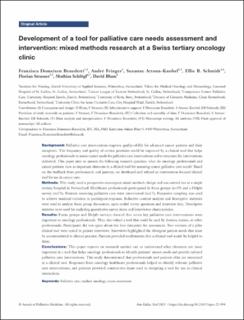Please use this identifier to cite or link to this item:
https://doi.org/10.21256/zhaw-27399Full metadata record
| DC Field | Value | Language |
|---|---|---|
| dc.contributor.author | Domeisen Benedetti, Franzisca | - |
| dc.contributor.author | Fringer, André | - |
| dc.contributor.author | Attoun-Knobel, Suzanne | - |
| dc.contributor.author | Schmidt, Ellie B. | - |
| dc.contributor.author | Strasser, Florian | - |
| dc.contributor.author | Schlögl, Mathias | - |
| dc.contributor.author | Blum, David | - |
| dc.date.accessioned | 2023-03-20T14:36:09Z | - |
| dc.date.available | 2023-03-20T14:36:09Z | - |
| dc.date.issued | 2023 | - |
| dc.identifier.issn | 2224-5820 | de_CH |
| dc.identifier.issn | 2224-5839 | de_CH |
| dc.identifier.uri | https://digitalcollection.zhaw.ch/handle/11475/27399 | - |
| dc.description.abstract | Background: Palliative care interventions improve quality-of-life for advanced cancer patients and their caregivers. The frequency and quality of service provision could be improved by a clinical tool that helps oncology professionals to assess unmet needs for palliative care interventions and to structure the interventions delivered. This paper aims to answer the following research question: what do oncology professionals and cancer patients view as important elements in a clinical tool for assessing unmet palliative care needs? Based on the feedback from professionals and patients, we developed and refined an intervention-focused clinical tool for use in cancer care. Methods: This study used a prospective convergent mixed methods design and was carried out at a single tertiary hospital in Switzerland. Healthcare professionals participated in focus groups (n=29) and a Delphi survey (n=73). Patients receiving palliative care were interviewed (n=17). Purposive sampling was used to achieve maximal variation in participant response. Inductive content analysis and descriptive statistics were used to analyze focus group discussions, open-ended survey questions and interview data. Descriptive statistics were used for analyzing quantitative survey items and interviewee characteristics. Results: Focus groups and Delphi surveys showed that seven key palliative care interventions were important to oncology professionals. They also valued a tool that could be used by doctors, nurses, or other professionals. Participants did not agree about the best timepoint for assessment. Two versions of a pilot clinical tool were tested in patient interviews. Interviews highlighted the divergent patient needs that must be accommodated in clinical practice. Patients provided confirmation that a clinical tool would be helpful to them. Conclusions: This paper reports on research carried out to understand what elements are most important in a tool that helps oncology professionals to identify patients’ unmet needs and provide tailored palliative care interventions. This study demonstrated that professionals and patients alike are interested in a clinical tool. Responses from oncology healthcare professionals helped to identify relevant palliative care interventions, and patients provided constructive input used in designing a tool for use in clinical interactions. | de_CH |
| dc.language.iso | en | de_CH |
| dc.publisher | AME Publishing | de_CH |
| dc.relation.ispartof | Annals of Palliative Medicine | de_CH |
| dc.rights | https://creativecommons.org/licenses/by-nc-nd/4.0/ | de_CH |
| dc.subject | Palliative care | de_CH |
| dc.subject | Medical oncology | de_CH |
| dc.subject | Needs assessment | de_CH |
| dc.subject.ddc | 610.73: Pflege | de_CH |
| dc.title | Development of a tool for palliative care needs assessment and intervention : mixed methods research at a Swiss tertiary oncology clinic | de_CH |
| dc.type | Beitrag in wissenschaftlicher Zeitschrift | de_CH |
| dcterms.type | Text | de_CH |
| zhaw.departement | Gesundheit | de_CH |
| zhaw.organisationalunit | Institut für Pflege (IPF) | de_CH |
| dc.identifier.doi | 10.21037/apm-22-994 | de_CH |
| dc.identifier.doi | 10.21256/zhaw-27399 | - |
| zhaw.funding.eu | No | de_CH |
| zhaw.issue | 3 | de_CH |
| zhaw.originated.zhaw | Yes | de_CH |
| zhaw.pages.end | 506 | de_CH |
| zhaw.pages.start | 496 | de_CH |
| zhaw.publication.status | publishedVersion | de_CH |
| zhaw.volume | 12 | de_CH |
| zhaw.publication.review | Open peer review | de_CH |
| zhaw.webfeed | G: Gesundheit im Alter | de_CH |
| zhaw.author.additional | No | de_CH |
| zhaw.display.portrait | Yes | de_CH |
| Appears in collections: | Publikationen Gesundheit | |
Files in This Item:
| File | Description | Size | Format | |
|---|---|---|---|---|
| 2023_DomeisenBenedetti-etal_Palliative-care-needs-assessment-and-intervention-tool.pdf | 307.1 kB | Adobe PDF |  View/Open |
Show simple item record
Domeisen Benedetti, F., Fringer, A., Attoun-Knobel, S., Schmidt, E. B., Strasser, F., Schlögl, M., & Blum, D. (2023). Development of a tool for palliative care needs assessment and intervention : mixed methods research at a Swiss tertiary oncology clinic. Annals of Palliative Medicine, 12(3), 496–506. https://doi.org/10.21037/apm-22-994
Domeisen Benedetti, F. et al. (2023) ‘Development of a tool for palliative care needs assessment and intervention : mixed methods research at a Swiss tertiary oncology clinic’, Annals of Palliative Medicine, 12(3), pp. 496–506. Available at: https://doi.org/10.21037/apm-22-994.
F. Domeisen Benedetti et al., “Development of a tool for palliative care needs assessment and intervention : mixed methods research at a Swiss tertiary oncology clinic,” Annals of Palliative Medicine, vol. 12, no. 3, pp. 496–506, 2023, doi: 10.21037/apm-22-994.
DOMEISEN BENEDETTI, Franzisca, André FRINGER, Suzanne ATTOUN-KNOBEL, Ellie B. SCHMIDT, Florian STRASSER, Mathias SCHLÖGL und David BLUM, 2023. Development of a tool for palliative care needs assessment and intervention : mixed methods research at a Swiss tertiary oncology clinic. Annals of Palliative Medicine. 2023. Bd. 12, Nr. 3, S. 496–506. DOI 10.21037/apm-22-994
Domeisen Benedetti, Franzisca, André Fringer, Suzanne Attoun-Knobel, Ellie B. Schmidt, Florian Strasser, Mathias Schlögl, and David Blum. 2023. “Development of a Tool for Palliative Care Needs Assessment and Intervention : Mixed Methods Research at a Swiss Tertiary Oncology Clinic.” Annals of Palliative Medicine 12 (3): 496–506. https://doi.org/10.21037/apm-22-994.
Domeisen Benedetti, Franzisca, et al. “Development of a Tool for Palliative Care Needs Assessment and Intervention : Mixed Methods Research at a Swiss Tertiary Oncology Clinic.” Annals of Palliative Medicine, vol. 12, no. 3, 2023, pp. 496–506, https://doi.org/10.21037/apm-22-994.
Items in DSpace are protected by copyright, with all rights reserved, unless otherwise indicated.